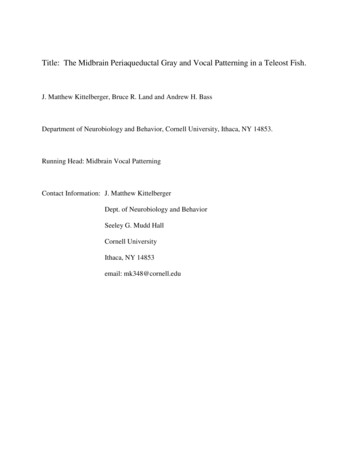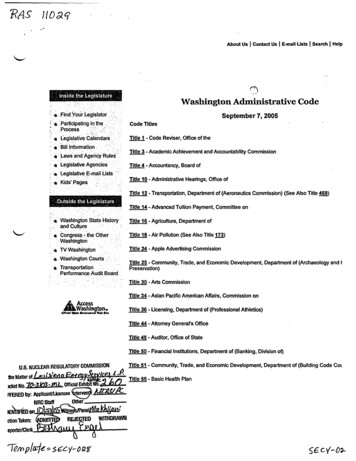
Transcription
Title: The Midbrain Periaqueductal Gray and Vocal Patterning in a Teleost Fish.J. Matthew Kittelberger, Bruce R. Land and Andrew H. BassDepartment of Neurobiology and Behavior, Cornell University, Ithaca, NY 14853.Running Head: Midbrain Vocal PatterningContact Information: J. Matthew KittelbergerDept. of Neurobiology and BehaviorSeeley G. Mudd HallCornell UniversityIthaca, NY 14853email: mk348@cornell.edu
Kittelberger, Land, and Bass: Midbrain Vocal PatterningAbstractMidbrain structures, including the periaqueductal gray (PAG), are essential nodes invertebrate motor circuits controlling a broad range of behaviors, from locomotion tocomplex social behaviors such as vocalization. Few single unit recording studies, so far allin mammals, have investigated the PAG’s role in the temporal patterning of thesebehaviors. Midshipman fish use vocalization to signal social intent in territorial andcourtship interactions. Evidence has implicated a region of their midbrain, located in asimilar position as the mammalian PAG, in call production. Here, extracellular single unitrecordings of PAG neuronal activity were made during forebrain-evoked fictivevocalizations that mimic natural call types and reflect the rhythmic output of a knownhindbrain-spinal pattern generator. The activity patterns of vocally active PAG neuronswere mostly correlated with features related to fictive call initiation. However, spike trainsin a subset of neurons predicted the duration of vocal output. Duration is the primaryfeature distinguishing call types used in different social contexts, and these cells may play arole in directly establishing this temporal dimension of vocalization. Reversible, lidocaineinactivation experiments demonstrated the necessity of the midshipman PAG for fictivevocalization, while tract-tracing studies revealed the PAG’s connectivity to vocal motorcenters in the fore- and hindbrain comparable to that in mammals. Together, these datasupport the hypotheses that the midbrain PAG of teleosts plays an essential role invocalization and is convergent in both its functional and structural organization to thePAG of mammals.
Kittelberger, Land, and Bass: Midbrain Vocal Patterningpage 1IntroductionThe midbrain periaqueductal gray (PAG) is proposed to play an essential role in the productionof vocal communication signals across vertebrates, including humans (Esposito et al. 1999;Jurgens 1994; Kennedy 1975; Seller 1981; Wild 1997). While inputs from forebrain limbicstructures, as demonstrated in mammals, support the PAG’s role in coupling motivational state tovocal behavior (Bandler and Shipley 1994; Behbehani 1995; Holstege 1998; Jurgens 2002;Sewards and Sewards 2003), few studies show how PAG neuronal activity shapes the temporalparameters of vocal motor output. PAG activity is clearly necessary for call initiation(Behbehani 1995; Jurgens 2002). Single unit recordings in vocalizing macaques show PAGactivity correlated with temporal features (e.g., duration) of vocalizations (Larson 1991; Larsonand Kistler 1986), implying a more direct role in vocal patterning than classically assumed(Davis et al. 1996; Jordan 1998; Jurgens 2002; Jurgens 1994; Swanson 2000). However, similarrecordings in squirrel monkeys do not reveal such correlations (Dusterhoft et al. 2004, 2000).While these findings may represent species differences, the interpretation is currentlycomplicated by an incomplete understanding of the relationship between ensemble muscleactivity and the acoustic properties of primate vocalizations. This makes it difficult to establishthe PAG’s exact role in vocal patterning. We therefore chose to examine this question in aspecies with a simple vocal repertoire and a more direct translation from neural activity patternto muscle action and vocal output.Midshipman fish (Porichthys notatus) depend on vocal communication for successfulcourtship and reproduction. Territorial males use sonic swim bladder muscles (Fig. 1A) toproduce several call types, differing primarily in duration (Brantley and Bass 1994) (Fig. 1B).
Kittelberger, Land, and Bass: Midbrain Vocal Patterningpage 2The sonic muscles are innervated by a hindbrain-spinal sonic motor nucleus (SMN) that receivesinput from nearby pacemaker neurons (PN) (Bass and Baker 1990) (Fig. 1C). The rhythmicoutput of the PN-SMN circuit, referred to as fictive vocalization, directly establishes musclecontraction rate and, in turn, call fundamental frequency (Bass and Baker 1990). A ventralmedullary nucleus (VM) links the PN-SMN circuitry to a midbrain region similar in location tothe mammalian PAG (Fig. 1C) (Bass et al. 1994; Goodson and Bass 2002). Electricalstimulation of this midbrain region elicits vocalization (Demski and Gerald 1974, 1972; Fine1979; Goodson and Bass 2002). The simplicity of vocal motor production, specifically a one-toone translation from the SMN spike train to acoustic properties of the call, make this an idealsystem for identifying the role of PAG neurons in vocal initiation and/or patterning.Here, we show that the activity patterns of a subset of PAG neurons are correlated with bothcall initiation and duration. In addition, direct manipulation of PAG activity by electricalmicrostimulation of descending PAG axons resulted in changes in call duration, furthersupporting a role for the PAG in temporal patterning. The necessity of PAG activity for vocalinitiation is shown by PAG-specific, reversible lidocaine blockade. Focal neurobiotin injectionsconfirm that the vocal motor connectivity of the midshipman PAG compares closely to that inmammals. Thus, two groups of distantly related vertebrates, teleost fish and mammals, sharemany functional and structural similarities in the descending control of vocalization.
Kittelberger, Land, and Bass: Midbrain Vocal Patterningpage 3Materials and MethodsAnimalsMidshipman fish (Porichthys notatus) have two male reproductive morphs that differ in vocaland spawning behaviors (Bass 1996). All experiments were performed on adult type I (territorial)males, which have the most dynamic vocal repertoire (Bass et al. 1999). Fish were collectedfrom tidal pool nesting sites or by offshore trawls in northern California and Washington,shipped to Cornell University, and maintained in artificial seawater tanks at 15o C. Allexperimental procedures were approved by the Cornell University Institutional Animal Care andUse Committee.SurgeriesSurgical procedures were similar to those described previously (Bass and Baker 1990;Goodson and Bass 2000c). Fish were anesthetized by immersion in 0.025 % benzocaine (ethylp-amino benzoate, Sigma, St. Louis, MO). Local anesthetic (0.2 ml of 0.25 % bupivacaine(Abbott Labs, N. Chicago, IL) with 0.01mg/ml epinephrine (International Medication Systems,So. El Monte, CA)) was then injected subdermally to the top of the head. The hypothalamus,midbrain, and hindbrain were exposed by dorsal craniotomy. Before transfer to the experimentalapparatus, fish were immobilized with an intramuscular injection of pancuronium bromide ( 5mg/kg, Baxter Healthcare, Deerfield, IL). For all experiments, fish were suspended in a parafilmsling in a plexiglass tank with their head stabilized, and artificial seawater at 15o C was perfusedcontinuously across their gills. Exposed portions of the brain were kept covered with an inert,
Kittelberger, Land, and Bass: Midbrain Vocal Patterningpage 4electrically conductive fluorocarbon (Fluorinert, 3M, St. Paul, MN). Fish were left to rest for 1hr before starting electrophysiology experiments to allow all residual benzocaine to wash outof their system.Extracellular recordingsFictive vocalizations: The vocal-motor output of the hindbrain vocal pattern generator, the“fictive vocalization”, was monitored with an extracellular electrode (75 µm diameter tefloncoated silver wire, A-M Systems, with an exposed ball tip of 125-200 µm in diameter) placed onan occipital nerve root that carries the axons of motor neurons from the ipsilateral sonic motornucleus to the ipsilateral sonic muscle; both sonic motor nuclei fire in phase (Bass and Baker,1990). These nerve root recordings were amplified 1000x and band-pass filtered from 1 Hz-20kHz with an A-M Systems differential AC amplifier (Model 1700).PAG neurons: Extracellular recordings from PAG neurons were obtained using glassmicroelectrodes (6010, A-M Systems) pulled to a tip resistance of 10-15 Mon aFlaming/Brown micropipette puller (Model P-97, Sutter Instruments, Novato, CA) filled with2M NaCl. The electrode tip solution also contained 5% dextran tetramethylrhodamine (10,000MW, D-1868, Molecular Probes, Eugene, OR) to label each recording site. Preamplified signalswere amplified 1000x total (Model NB-100 amplifier, Biomedical Engineering, Thornwood, NYand an A-M Systems, Model 1700 differential AC amplifier) and band-pass filtered from 0.3-10kHz.
Kittelberger, Land, and Bass: Midbrain Vocal Patterningpage 5Forebrain stimulation of PAG neurons and fictive vocalizationsRationale: Previous studies established the medial longitudinal fasciculus (MLF) of themidbrain as a site where low-amplitude stimulation evokes naturalistic vocalizations (Demskiand Gerald 1972; Fine and Perini 1994). Thus, our preliminary experiments focused on the MLFand showed that stimulation here elicited reliable vocal responses that did not fatigue withrepeated stimulation. These experiments facilitated the reliable localization and isolation ofsingle PAG neurons with stimulus-modulated activity concurrent with stimulus-evoked fictivevocalizations. However, our ongoing anatomical studies showed the MLF to be the maindescending pathway for PAG axons (see last section of Results). Thus, changes in PAG neuronfiring evoked by MLF stimulation were likely antidromically mediated, and therefore would notresemble the endogenous pattern of vocal-related PAG activity during spontaneous vocalization.Neuroanatomical and brain stimulation studies suggested that the ventral tuberal hypothalamus(vT) was a likely candidate for a source of descending input to the PAG (Goodson and Bass2000a, 2002), as we later confirmed in our own anatomical studies (Results). Stimulation at sitesin and around vT evoked a less reliable vocal response, at longer and more variable latency, thattended to fatigue with repeated stimulation. Although these features made it more difficult toisolate vocal-related PAG neurons, all of the available data indicated that PAG activity evokedby stimulating vT should be more reflective of endogenous PAG vocal activity patterns.Therefore, for the purposes of this paper, we present data from 48 PAG neurons recorded duringvT stimulation. The results of the MLF stimulation experiments were used to analyze howdescending midbrain output, inclusive of PAG axons, affects features of the vocal response (seebelow).
Kittelberger, Land, and Bass: Midbrain Vocal Patterningpage 6Procedures: Surface landmarks and micromanipulator coordinates were used to guide insulatedtungsten stimulating electrodes (125 µm diameter, 8o tip angle, 5 Mimpedance; A-M Systems,Sequim, WA) to sites in or near either vT or the MLF. Brief trains of stimuli (3-15 pulses,1msec pulse duration, 333Hz repetition rate, 50-75 µA) were delivered using a WPI stimulusisolation unit (Model 850A, New Haven, CT), with stimulus timing parameters driven byTucker-Davis System II software and hardware (Alachua, FL). The stimulating electrode waslowered into the brain until a stable reliable vocal output was obtained. The extracellularelectrode was then positioned over the PAG and advanced into the brain using a Burleighmicrodrive (Model LSS-1000, Burleigh Instruments, Fishers, NY). Once the electrode was atthe approximate correct depth, we began searching for units whose activity was clearlymodulated by the stimulus. Since the vocal response elicited by vT stimulation tended to fatiguewith repeated stimulation, we typically repeated only about 40 stimulus sweeps (1 every 2 s) at atime, followed by a 5-10 min rest interval. This stimulation pattern was followed both whilesearching for PAG units and while acquiring data once a stable unit was isolated. As PAGneurons tended to have either low or no spontaneous activity (see Results), units were often onlydetected based on the presence of stimulus-evoked action potentials. Once a stable unit wasisolated, spike and vocal output data were recorded while the stimulus duration was varied,resulting in changes in the latency, duration, and probability of the vocal response. Spontaneousspike data were also recorded. After recording, the recording sites were marked by injectingpulsed positive current ( 3 µA, 50 % duty cycle, 10 min) to iontophorese the fluorescent dyeout of the electrode tip. In addition, stimulation sites were confirmed after each experiment bythe small electrolytic lesion left at each site.
Kittelberger, Land, and Bass: Midbrain Vocal Patterningpage 7Data Analysis and Statistics of PAG Neuronal ActivityBoth PAG and nerve root signals were digitized at 50 kHz, and were acquired using a TuckerDavis System II data acquisition system with BrainWare v6.3 software (Tucker-Davis). Initialpost hoc analyses of the extracellular and vocal nerve recordings were performed with Brainwarev6.3 software (Tucker-Davis). The shapes of all action potentials were examined, and multipleunits, when present, were defined based on differences in various parameters of spike shape(amplitude of each peak, inter-peak interval). When all spikes were plotted in parameter space,distinct clusters were readily apparent. Visual inspection of voltage versus time plots of eachcluster confirmed that all spikes within a cluster were from the same unit (e.g., Fig. 1D). Thefew spikes that did not conform to cluster boundaries were discarded. Of the 143 total neuronsrecorded, the majority of all recording sites were single units (112 of 127); of the 15 multi-unitsites, 14 revealed two clearly distinguishable units each, and one revealed 3 clear units. The 48units recorded during vT stimulation represent 42 separate recording sites: 36 sites with only asingle unit plus 6 sites each yielding two clearly distinguishable single units. The spike times foreach unit, and for the coincident nerve recording of the vocal response pulses, were exported forfurther analysis.Custom Matlab scripts (version 7.0.1 (R14), The Math Works) were used to compile, annotate,and analyze the spike records. For each unit confirmed by histology to be in the PAG (seebelow), we calculated (Table 1): 1) the mean spontaneous firing rate (from trials with nostimulus), 2) the net mean number of stimulus-evoked spikes (over the first 800 msec post-stim,reduced by the number of expected spontaneous spikes), 3) the mode of the inter-spike intervaldistribution, 4) the latency to the first post-stimulus spike, and 5) the mean lag time between the
Kittelberger, Land, and Bass: Midbrain Vocal Patterningpage 8first post-stimulus unit spike and the first pulse of the vocal response. In addition, for each ofthese fish, we determined various parameters of the vocal response, including (Table 1): 1) thetotal mean number of pulses (over the first 800 msec post-stimulus), 2) the mean number ofpulses in the first vocal burst (a burst was defined as a series of pulses, each separated from thenext by no more than 50 msec), 3) the latency to the first pulse of the vocal response, 4) the meaninter-pulse interval, and 5) the mean inter-burst interval. Post-stimulus time histograms (PSTH)for each unit and vocal response, peri-event time histograms (PETH) for each unit (centered onthe time of the first vocal response pulse), and frequency distributions of inter-spike intervals(for each unit and vocal response) were plotted using Origin version 6.1 software (Origin LabCorp., Northampton, MA).Statistical analyses, including tests for trial-by-trial correlations between the unit spike activityand the vocal response, were performed using JMP version 5.0.1a software (SAS Institute, Cary,NC). For each unit, we tested for 3 possible correlations: 1) between the net number ofstimulus-evoked unit spikes and the total number of vocal response pulses, 2) between the netunit spikes and the latency of the vocal response, and 3) between the latency of the unit responseand the latency of the vocal response. The total number of vocal response pulses per trial reflectsthe product of the probability of a vocal response times the duration (number of pulses) of eachvocal burst times the number of vocal bursts. In order to directly determine whether unit activitypredicted burst duration, an additional (fourth) correlation was assessed between the number ofvocal pulses in the first vocal burst on each trial and the net number of unit spikes up to the endof this vocal burst. Trials with no vocal response were excluded from this analysis. Note thatbecause the inter-pulse interval of all vocal responses was relatively invariant (see Table 1), the
Kittelberger, Land, and Bass: Midbrain Vocal Patterningpage 9number of vocal pulses is highly predictive of the total time duration of vocalization. Wetherefore use number of vocal pulses to represent vocal duration throughout this paper.It seemed likely that variation in the number of stimulus pulses from trial to trial could affectboth the unit activity and the vocal response separately. We therefore wanted to be sure that anydetected correlations between the unit activity and the vocal response were not being driven bychanges in the stimulus duration. Thus, for all four correlational analyses, we ran multi-variateregressions with both stimulus pulse number and unit activity (either latency or net spikes) asindependent variables. In addition, we tested for correlations between the vocal response andunit activity on the subset of trials in which stimulus duration was kept constant. Because forsome neurons there was little data at particular stimulus durations, the multi-variate regressionanalysis was used as the criterion for whether or not there was a significant correlation betweenunit activity and vocal response for each cell. For clarity, however, the illustrative data presentedin the figures is only for trials in which stimulus duration was held constant. Finally, for eachcell, we tested whether the net number of unit spikes was different on trials on which a vocalresponse occurred than on trials on which the vocal response failed (while holding stimulusduration constant).To compare how tightly each unit’s spike pattern was timed relative to the stimulus onsetversus the vocal onset, we calculated the width of each PSTH and PETH distribution peak at halfmaximal height. These distributions were noisy: the spikes per time bin often did not decaysmoothly away from the peak. We calculated the width at the first time point greater and lessthan the peak time where the number of spikes per bin fell below half the number of spikes in thepeak bin, and again at the last time points (i.e., furthest from the peak) where the spikes per binfell below this half peak value. The former number will tend to underestimate the half-height
Kittelberger, Land, and Bass: Midbrain Vocal Patterningpage 10width of the distribution, while the latter will overestimate this width. We averaged theseminimum and maximum values to arrive at a final estimate of the width of both the PSTH andPETH spike distributions for each unit. A comparison of these two numbers was used to judgewhether spike timing for each cell was more tightly locked to the stimulus onset or to the vocalonset.MLF stimulation of vocal outputWe wanted to directly test whether altering the ensemble output of PAG neurons influencedspecific parameters of the vocal response, including temporal features such as call duration andinter-pulse interval. To do so, we analyzed the properties of fictive vocal responses elicited bystimulation of the MLF (as described above). All stimulation sites were confirmed histologicallyto be in the MLF, through which PAG axons descend to connect with the hindbrain vocal circuit.We systematically altered the number of stimulation pulses (stimulus duration), and analyzedfour features of the vocal response that might change in correlation with stimulus duration: 1) theduration of the stimulus-evoked vocal burst (number of vocal pulses), 2) the probability ofeliciting a vocal response, 3) the latency to the vocal response, and 4) the mean interval betweenpulses within the vocal response. All 4 features were quantified at each stimulus duration.Using SAS version 9.1.3 statistical software (SAS Institute), we ran repeated measures ANOVAsto ask whether there was a significant effect of stimulus duration on each of these 4 vocalparameters across experiments.
Kittelberger, Land, and Bass: Midbrain Vocal Patterningpage 11Lidocaine inactivation experiments.In these experiments, we sought to determine whether reversible inactivation of the PAGaffected the stimulus-evoked vocal output. Surgeries, vT stimulation, and vocal nerve recordingwere as described above. Once a stable and reliable vocal response was obtained, we recordedthe baseline response for at least 40 min (16-24 stimulus trials every 10 min). About 6-7 minafter the final baseline recording, a glass micropipette containing 4 % lidocaine hydrochloride(Sigma) and 4% fluorescent dextran conjugate (either fluorescein- or tetramethylrhodamine-,Molecular Probes) in 0.1 M phosphate-buffered saline (PBS) was stereotactically guided to PAG.Micropipettes were made as described above for extracellular recording electrodes, but the tipswere broken back to 5-10 µm inner diameter. Either lidocaine or control (vehicle plus dyeonly) solution was pressure-ejected from the pipette using a picospritzer (BiomedicalEngineering) set to deliver 1 pulse per second, 10-50 msec duration each, at 25-30 psi, for 30 s,for a total injection volume of approximately 0.5 nl. We continued to record the stimulusevoked vocal responses for up to an hour post-injection. PAG injections were bilateral,ipsilateral to the stimulus, or contralateral. In some fish, control injections were targeted tomidbrain areas outside the PAG, including the torus and ventral tectum. In some cases post-hocanalysis revealed that injections intended for the PAG had in fact missed; these injections werealso treated as controls. Vehicle (PBS) only or sham injections to the PAG were used asadditional controls. Typically, 1 experimental and 1 control injection were made in each fish,with at least 60 min between the 2 injections, allowing for complete recovery from any effect ofthe first injection on the vocal response. The locations of the injection sites were confirmed posthoc (see below).
Kittelberger, Land, and Bass: Midbrain Vocal Patterningpage 12Post hoc analyses were similar to the extracellular single unit analysis described above. Vocalresponse pulses were discriminated using Brainware, and pulse times were exported for furtheranalysis. Matlab scripts were used to compile and annotate the data, and to calculate the meannumber of vocal response pulses over the first 800 msec post stimulus for each time point preand post-injection. Data were graphed in Origin, and statistical analysis performed using JMP.Within each experiment, an injection was determined to have had a significant effect on thevocal response if: 1) there was a significant overall effect of time on the mean vocal responseover the duration of the experiment, and 2) a Tukey-Kramer test indicated that the vocal responseat a minimum of at least one time point within the first 20 minutes post-injection wassignificantly less than at a minimum of at least two time points during the pre-injection baseline.To analyze the data by treatment type, we first normalized the post-injection vocal response datato the mean pre-injection baseline response for each experiment, and then pooled this normalizeddata by treatment type. Within each treatment type, we performed a repeated measures ANOVAacross the experimental time points. Because the data were normalized to the pre-injectionbaselines, a significant effect of time indicates a consistent post-injection effect within the group.In such cases we also determined which post-injection time points were different from preinjection using a Tukey-Kramer test, with a significance level of 0.05.Tract tracing experiments.To characterize the connectivity, both antero- and retrograde, of neurons in the PAG, we madefocal iontophoretic injections of 5% neurobiotin (Vector Labs, Burlingame, CA). Surgeries wereas described above, except that only a small craniotomy was made over the midbrain on one side.
Kittelberger, Land, and Bass: Midbrain Vocal Patterningpage 13Fish were transferred to the recording rig, and glass micropipettes were stereotactically guided tothe PAG. Micropipettes were the same as those used as extracellular recording electrodes.Neurobiotin (in 2M KCl) was iontophoresed for 5-10 min using 3 µA pulsed current (15 s on /15 s off). Only a single injection was made in each fish. After a 10 h survival time to allowtransport of the tracer, fish were perfused and brains processed as described below.HistologyAt the end of all experiments, fish were deeply anesthetized (0.025 % benzocaine) andperfused with ice-cold, teleost Ringer’s solution with 10 units/ml of heparin (Elkins-Sinn, CherryHill, NJ), followed by 4 % paraformaldehyde in 0.1 M phosphate buffer (PB). Brains wereremoved, post-fixed overnight, and transferred to 0.1 M PB (pH 7.2) for storage. Brains wereequilibrated in 30 % sucrose for 24 h and then sectioned transversely at 50 µm on a freezingmicrotome. For brains with fluorescent dye injections (fluorescein- or rhodamine-dextran, as inthe recording and lidocaine inactivation experiments), sections were collected in 0.1M PB,mounted immediately on gelatin subbed slides, dried overnight, and coverslipped using afluorescent mounting medium (Vectashield, Vector Labs). Neurobiotin injections, as used in thetract-tracing experiments, were visualized using a standard avidin-biotin-peroxidase protocol.Briefly, sections were collected in PBS, permeabilized for 30 min in PBS with 0.04% TritonX100 (Sigma), incubated for 3h at room temperature in avidin-biotin-peroxidase in PBS(Vectastain ABC Elite, Vector Labs), rinsed twice in PB, reacted with 0.05% diaminobenzidine(Sigma) and 0.0072% H2O2 in PB, rinsed twice more in PB, and mounted on gelatin subbedslides. Alternate sections were mounted on separate slides, dried overnight, cleared in xylene,
Kittelberger, Land, and Bass: Midbrain Vocal Patterningpage 14and coverslipped. Later, one set of sections was stained with 0.5% cresyl violet (Sigma) todelineate the borders of the different cell clusters. Sections were examined andphotomicrographs taken on a Nikon Eclipse E-800 microscope.ResultsExtracellular recording of vocal-related activity in PAGExtracellular recordings were made from a total of 143 isolated units in the midbrains of 53type I male midshipman fish, while stimulating different sites to elicit vocal output (seeMethods). Of these, a total of 48 neurons were recorded from 23 fish while vocal responseswere being elicited by microstimulation of vT, a known vocal structure providing descendingafferent input to the PAG (see Methods, and last section of Results). Twenty-four of these 48neurons, in 12 fish, were confirmed histologically post hoc to be in the PAG (e.g., Fig. 6C), acompact cell layer along the periventricular surface of the midbrain (Fig., 6A, B, K). Recordingsites were often (21/24) localized to the PAG axons just ventral to the main PAG cell body layer(e.g., Fig. 6C), but all 24 of these sites had clearly back-filled neurons within the PAG proper.Of the 24 neurons outside the PAG whose activity was also modulated by vT stimulation, 11were localized to the ventral tectum, 9 were in the midbrain tegmentum, and 4 were rostral of thePAG, in the dorsal thalamus; in none of these recording sites were there any back-filled neuronsin the PAG. The mean and median values, including range and standard deviations, forspontaneous and stimulus-evoked firing properties of PAG neurons are summarized in Table 1.All cells fired spontaneous action potentials at either a low rate (up to 8 Hz; 17 cells) or not at all
Kittelberger, Land, and Bass: Midbrain Vocal Patterningpage 15(7 cells). Ventral tuberal stimulation induced an excitatory response in all PAG neuronsrecorded. From cell to cell, this response ranged from a single, short-latency spike (9 cells), toeither a discrete burst of spikes or a broad, longer-lasting increase in firing that decayed back tothe spontaneous baseline over several hundred msec. In 18 of the 24 cells, the mean latency tothe first post-stimulus spike was 50 msec.Stimulus-evoked unit spiking typically began well before the vocal response, and some unitscontinued to fire during the fictive vocalization (Fig. 2A1, B1). This relationship is bestvisualized by comparing the post-stimulus time histograms (PSTH) of vocal and unit activity(e.g., Fig. 2A2 vs. A3, B2 vs. B3). In 23 of the 24 PAG units, the peak of the unit PSTHpreceded the peak of the vocal PSTH, across all trials. In addition, we computed the mean lagtime as the difference between the times of the first unit spike and of the first vocal pulse, usingonly trials where both occurred. The mean lag time for the population of PAG units (–165.6 /110 msec) was significantly less than 0 (p 0.0001, ANOVA). All but 2 PAG units had meanlag times less than 0, that is, unit leading vocal. However, there was a great deal of variation,both from unit to unit, and from trial to trial within each unit, in the lag time magnitude (seeTable 1).When examining the trial-to-trial raster plots of spike versus vocal activity (e.g., Fig. 2A1, B1),it was clear that much of the trial-to-trial variance in either the latency or d
Kittelberger, Land, and Bass: Midbrain Vocal Patterning page 2 The sonic muscles are innervated by a hindbrain -spinal sonic motor nucleus (SMN) that receives input from nearby pacemaker neurons (PN) (Bass and Baker 1990) (Fig. 1 C). The rhythmic output of the PN -SMN circuit, referred to as fictive voca lization, directly establishes muscle










